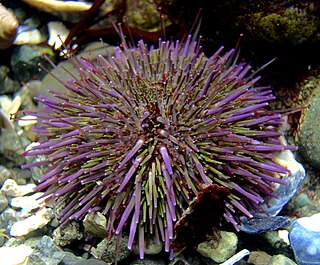Related Research Articles

Sea urchins are spiny, globular echinoderms in the class Echinoidea. About 950 species of sea urchin live on the seabed of every ocean and inhabit every depth zone — from the intertidal seashore down to 5,000 metres. The spherical, hard shells (tests) of sea urchins are round and spiny, ranging in diameter from 3 to 10 cm. Sea urchins move slowly, crawling with tube feet, and also propel themselves with their spines. Although algae are the primary diet, sea urchins also eat slow-moving (sessile) animals. In the food chain, the predators who eat sea urchins are the sea otter and the starfish, the wolf eel, the triggerfish, and human beings.

Strongylocentrotus purpuratus, the purple sea urchin, lives along the eastern edge of the Pacific Ocean extending from Ensenada, Mexico, to British Columbia, Canada. This sea urchin species is deep purple in color, and lives in lower inter-tidal and nearshore sub-tidal communities. Its eggs are orange when secreted in water. January, February, and March function as the typical active reproductive months for the species. Sexual maturity is reached around two years.

Strongylocentrotus droebachiensis is commonly known as the green sea urchin because of its characteristic green color. It is commonly found in northern waters all around the world including both the Pacific and Atlantic Oceans to a northerly latitude of 81 degrees and as far south as Maine and England. The average adult size is around 50 mm (2 in), but it has been recorded at a diameter of 87 mm (3.4 in). The green sea urchin prefers to eat seaweeds but will eat other organisms. They are eaten by a variety of predators, including sea stars, crabs, large fish, mammals, birds, and humans. The species name "droebachiensis" is derived from the name of the town Drøbak in Norway.

The Strongylocentrotidae are a family of sea urchins in the order Echinoida.
Aquimarina intermedia is a Gram-negative, heterotrophic, aerobic bacterium from the genus of Aquimarina which has been isolated from the sea urchin Strongylocentrotus intermedius from the Peter the Great Gulf in Russia.
Tsuneonella troitsensis is a Gram-negative, aerobic, halotolerant, rod-shaped and motile bacterium from the genus Tsuneonella which has been isolated from the sea urchin Strongylocentrotus intermedius.
Arenibacter echinorum is a heterotrophic and aerobic bacterium from the genus of Arenibacter which has been isolated from the sea urchin Strongylocentrotus intermedius from the Sea of Japan.
Roseivirga echinicomitans is a Gram-negative, heterotrophic, strictly aerobic and non-motile bacterium from the genus of Roseivirga which has been isolat from the sea urchin Strongylocentrotus intermedius.
Echinicola is an aerobic and motile bacterial genus from the family of Cyclobacteriaceae.
Echinicola pacifica is a heterotrophic and motile bacterium from the genus of Echinicola which has been isolated from the sea urchin Strongylocentrotus intermedius from the Troitsa Bay in the Sea of Japan.
Arenicella chitinivorans is a Gram-negative, rod-shaped, strictly aerobic and non-motile bacterium from the genus of Arenicella which has been isolated from the sea urchin Strongylocentrotus intermedius.
Mariniflexile is a genus in the phylum Bacteroidota (Bacteria). The various species have been recovered from sea water, sea urchins, springs, brackish water, and an oyster.
Gramella echinicola is a Gram-negative and halophilic bacterium from the genus of Gramella which has been isolated from the sea urchin Strongylocentrotus intermedius from the Sea of Japan.
Gramella marina is a Gram-negative, aerobic and heterotrophic bacterium from the genus of Gramella which has been isolated from the sea urchin Strongylocentrotus intermedius.

Strongylocentrotus intermedius is a species of sea urchin described by Alexander Agassiz in 1864.
Lutibacter holmesii is a Gram-negative, strictly aerobic, rod-shaped and non-motile bacterium from the genus of Lutibacter which has been isolated from a sea urchin from the Troitsa Bay in the Sea of Japan.
Salegentibacter mishustinae is a Gram-negative, strictly aerobic, heterotrophic and non-motile bacterium from the genus of Salegentibacter which has been isolate from a sea urchin from the Sea of Japan.
Winogradskyella echinorum is a bacterium from the genus of Winogradskyella which has been isolated from the sea urchin Strongylocentrotus intermedius.
Echinimonas is a Gram-negative, facultatively anaerobic and motile genus of bacteria from the family of Vibrionaceae with on known species Echinimonas agarilytica. Echinimonas agarilytica has been isolated from the sea urchin Strongylocentrotus intermedius.
Alkalihalobacillus haemicentroti is a Gram-positive, moderately halophilic, facultatively alkaliphilic, endospore-forming, facultatively anaerobic and non-motile bacterium from the genus of Alkalihalobacillus which has been isolated from a sea urchin from the Naozhou Island.
References
- 1 2 "Species: Alkalihalobacillus berkeleyi". lpsn.dsmz.de.
- 1 2 Nedashkovskaya, Olga I.; Van Trappen, Stefanie; Frolova, Galina M.; De Vos, Paul (March 2012). "Bacillus berkeleyi sp. nov., isolated from the sea urchin Strongylocentrotus intermedius". Archives of Microbiology. 194 (3): 215–221. doi:10.1007/s00203-011-0771-0.
- 1 2 "Alkalihalobacillus berkeleyi". www.uniprot.org.